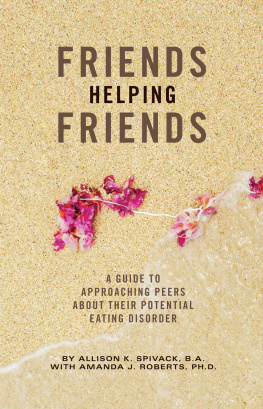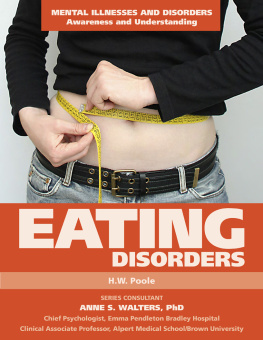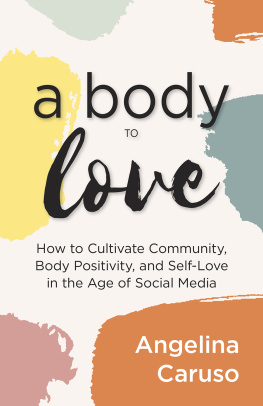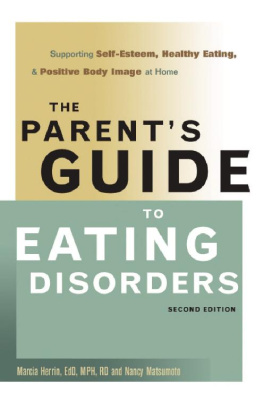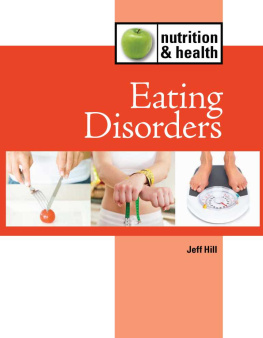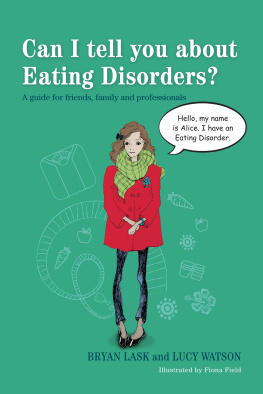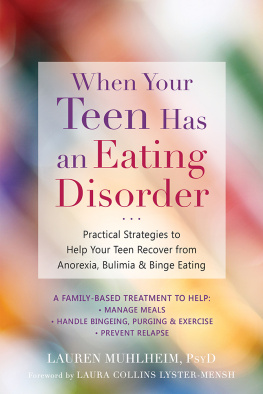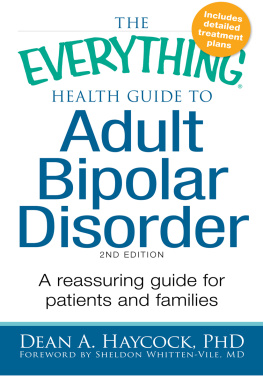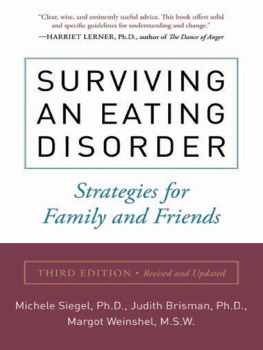FRIENDS HELPING FRIENDS
A Guide to Approaching Peers
About Their Potential Eating Disorder
By Allison K. Spivack, B.A.
With Amanda J. Roberts, Ph.D

Copyright 2011 by Allison K. Spivack, B.A. and Amanda J. Roberts, Ph.D.
All rights reserved. No part of this publication may be reprinted, reproduced, transmitted, or utilized in any form or by any electronic, mechanical, or other means, now known or hereafter invented, including photocopying, microfilming, and recording, or in any information retrieval system without the written permission of Cognella, Inc.
First published in the United States of America in 2011 by Cognella, Inc.
Trademark Notice: Product or corporate names may be trademarks or registered trademarks, and are used only for identification and explanation without intent to infringe.
Photography by: Sarah M. Mohler, B.S.
ISBN: 978-1-63189-699-6

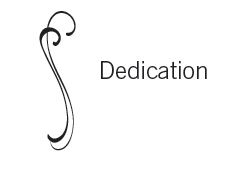
For Abby, Mom and Dad, and my endless list of genuinely remarkable friends.
Love Always, Allison
Introduction
O ver the course of my junior year of college, one of my closest friends developed an eating disorder. This was further perpetuated and complicated by her severe swings in and out of depressive states. Although the disorder did not manifest fully until the summer, she demonstrated many of the classic warning signs such as poor body image, denial of hunger, and irritability.
She would return from weekends at home or simply a day of class and tell me she had not eaten. At first I did not think her behavior was too unusual because when my life becomes extremely busy, I have a tendency to skip meals. But her actions continued and hints about her declining well-being were dropped frequently. In addition, personal traumas had worsened and taken a toll on her to such an extent that I found her crying on the floor of her closet one night in a frightening catatonic state.
This was not the first time I had seen her behave this way, and after much discussion and demonstration of exactly how terrified I was she finally agreed to go to therapy. Showing your friends and family how much you care about and love them is a huge aspect in their recovery. I think the one thing that scared my friend the most was when I told her about my sisters death 2 1/2 years earlier and how my mom had found her in bed and not breathing. I looked my friend straight in the eye and told her I refused to go to another funeral that year and that anorexia nervosa is the deadliest psychiatric disorder. I also told her I was terrified of returning home one afternoon only to find her just as my mom had discovered my sister.
Ultimately her story of trauma and current recovery is what inspired me to compile information and assemble this guide. She is still one of the most amazing people I know and I am extremely proud of her for taking care of herself. I hope this guide serves as a helpful tool and that you too can help a friend in need. I created it because I lacked the resources and reference guides to help me navigate this life experience. Thank you for taking the time to read this through. I hope you learn a great deal and gain the confidence and courage to approach a peer about her or his behavior. Most important, though, be supportive and be a friend.
Loving Your Body and Societys Impact: Body Image and Cultural Perspectives
M odern American culture portrays mixed messages about the human body. Our society often projects the coathanger-thin image of a catwalk model as the ideal representation of health, success, and happiness for women. The ideal man is often thin, but very muscular or sometimes also very thin. These images combined with numerous advertisements for diet and exercise programs following those for fast foods, sugary cereal, and soda cause much confusion in peoples minds. The intense focus on body image in American culture pushes into the American consciousness food, dieting, exercise, and the fact that a person working incredibly hard to lose weight is not good enough because that person will never be as thin as the models they watch in haute couture runway shows. Our society often encourages the achievement of this thin ideal since the message of thinness inextricable link to happiness, success, wealth, love, and intimacy remains at the heart of what is conveyed to the population. Advertisements rely on the fact that sex sells. They also tend to toy with their audiences in efforts to make them believe that consuming a particular food item, like Paris Hilton does in a Carls Jr. television ad, will bring about ones good fortune. Thus dieting and this thin ideal remain focal points in the American cultural perspective.
Americans are taught to pursue the thin ideal while simultaneously being bombarded by media messages demonstrating the convenience, low cost, and high availability of fast food. This constant barrage of advertisements reinforces our focus on the skinny of things and our desire to be categorized as thin that only serves to spark or further perpetuate a dangerous obsession with all things food-related. This phenomenon even infiltrates our manner of ordering coffee in that people now order skinny beverages of skim milk and sugar-free syrup. In this sense diet has fully risen to the center of our thinking and often consumes a good portion of our daily thoughts and actions.
Dieting has evolved into somewhat of a religion within modern American culture seeing as so much of our time, effort, and money is spent altering ourselves to match a prescribed image that only a very small percentage of the world naturally fills. Food is used to mark every occasion from joyous to sorrowful. It is used as a source of comfort and of love. While food is essential and to be enjoyed, some take it to an extreme and use the restriction or overindulgence of food with or without compensatory behaviors, as coping mechanisms. Sometimes this is done as an act of defiance, a call for attention, or because some other trauma triggered it. While eating disorders do not solely arise out of genetics, those with parents or siblings affected by such psychopathologies remain in a higher risk category for having this type of disorder. Ultimately it is a combination of ones biology and environment that determines whether or not they will develop an eating disorder.
That said, it is important to break down what qualifies as nondisordered eating. Is it actually possible? Who doesnt have a specific way they like a dish prepared or certain ingredients they prefer (for example the use of non-fat milk instead of 2-percent or whole milk)? Every culture has specific dietary rules and means of eating. Some cultural diets focus on meat, others on no meat at all, and some on a mixture. However, human cultural evolution produced a crude shift in our thinking about food. The ideas that initially laid the foundation for a survival-based focus morphed into a desire-based focus in which humans eat for many more reasons than actual physical hunger.
This focus shift coincides with the cultural change in perspectives on body image. While individual experiences tailor a persons beliefs, ideas, and self-image, the overall cultural skinny/thin and muscular/six-pack abs ideal is the ultimate rule by which many women and men measure themselves. The search for perfection, rooted in severe disturbances and distortions in ones perception of their appearance combined with their overall body dissatisfaction, is often one of the main catalysts that ultimately contributes to the development of an eating disorder. These disturbances and distortions that fuel body dissatisfaction also influence self-evaluation, which is oft en affected by a persons body shape, weight, and investment in these things.
Next page
